The Fried Egg Nebula (Hen 3-1379) is a nebula surrounding the yellow hypergiant star IRAS 17163-3907 in the constellation Scorpius. The expanding shell of gas lies approximately 3,900 light-years away. It is one of the brightest mid-infrared sources in the sky. The appearance of the huge dusty double shell of material expelled from the star has earned the nebula the nickname the Fried Egg Nebula.
The yellow hypergiant IRAS 17163-3907 has the spectral class A3-A6Ia. With a mass of around 22 solar masses, it is a supernova candidate. The star has a radius 325 times that of the Sun and shines with a luminosity of 500,000 Suns. It has a surface temperature of 8,300 – 8,500 K.
Yellow hypergiants are among the rarest classes of stars. They have extended atmospheres and are among the visually brightest stars known, with absolute magnitudes of about -9 to -9.5. The central star of the Fried Egg Nebula has an absolute magnitude of around -10. It has been compared to IRC +10420 (V1302 Aquilae), a yellow hypergiant in the constellation Aquila, and the luminous blue variable Wray 15-751 (V432 Carinae) in Carina, which are also surrounded by nebulae.
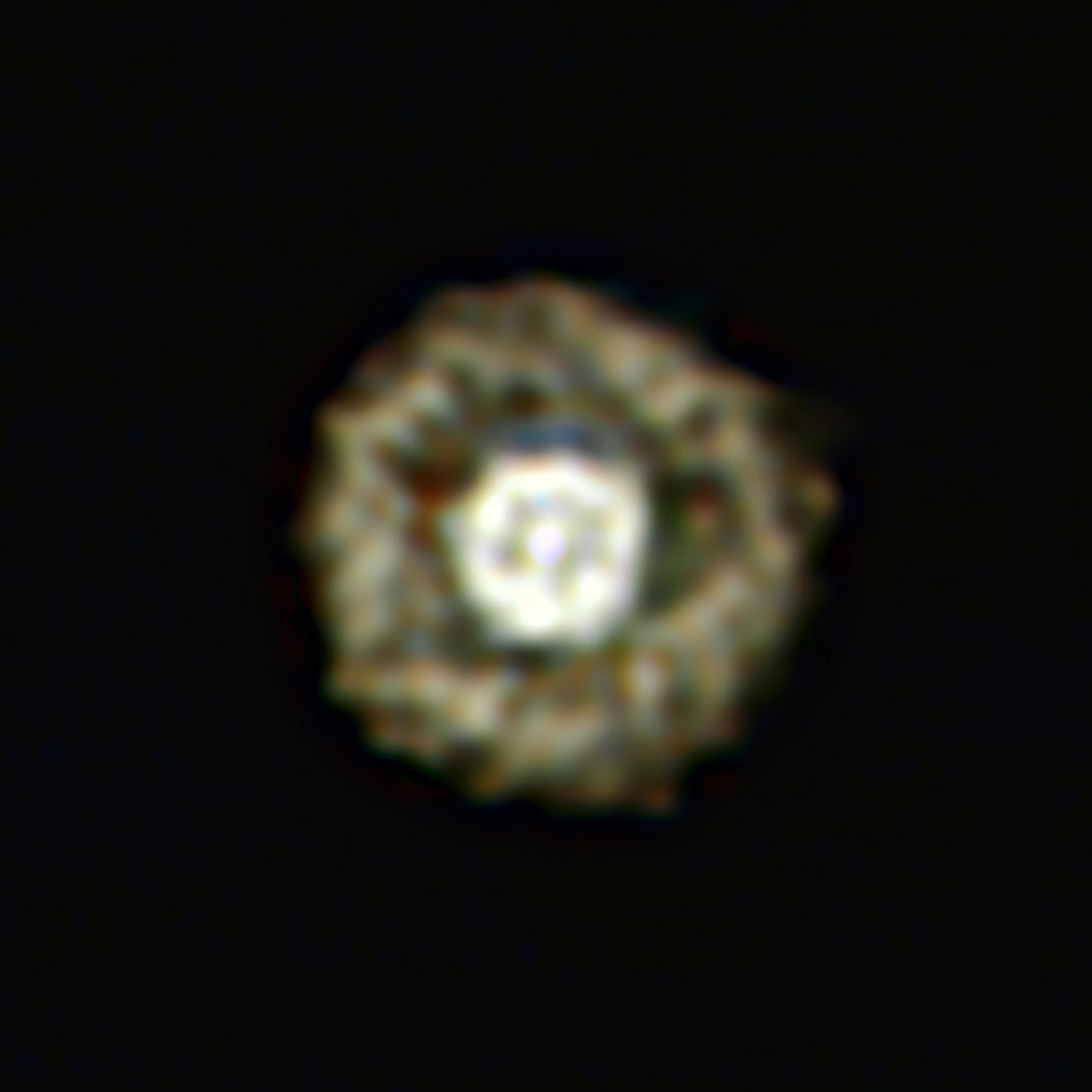
This picture of the nebula around a rare yellow hypergiant star called IRAS 17163-3907 is the best ever taken of a star in this class and shows for the first time a huge dusty double shell surrounding the central hypergiant. The star and its shells resemble an egg white around a yolky centre, leading astronomers to nickname the object the Fried Egg Nebula. Image credit: ESO/E. Lagadec (CC BY 4.0)
Only about 20 yellow hypergiants are known in our Milky Way galaxy. These are exceptionally massive stars with initial masses around 20-60 times that of the Sun. They can lose half their initial mass over the course of their evolution. Their intense mass loss greatly contributes to the chemical enrichment of the interstellar medium.
In addition to low gravity, these large stars pulsate irregularly, which causes small variations in their temperature and brightness. The pulsations and low gravity also cause severe mass loss. As a result, these stars are often surrounded by nebulosity composed of expelled material.
The extensive double shell of gas expelled from the central massive star of the Fried Egg Nebula was classified as a protoplanetary nebula in 2003 based on data obtained in the 2.2 micron infrared sky survey. The spherical shells were produced in several discrete mass loss events.
The distance to the Fried Egg Nebula was long uncertain, with different studies deriving very different values. This led to different classifications for the central star as well. The distance of 1,200 parsecs (~3,900 light years) comes from a 2020 study led by E. Koumpia, School of Physics & Astronomy, University of Leeds, UK, and R. D. Oudmaijer, European Southern Observatory, ESO Vitacura, Chile. This distance makes IRAS 17163-3907 the closest yellow hypergiant to the Sun.
The estimate is based on the parallax of IRAS 17163-3907 in the Gaia Data Release 2 (GDR2). The team calculated a distance in the range between 1000 pc (3,261.56 ly) and 1,600 pc (5,218.5 ly), about three times closer than several studies had previously suggested. However, when corrected for reddening, the astronomers found a luminosity 500,000 times that of the Sun, allowing the massive star to keep its status as a yellow hypergiant.
Based on optical and near infrared spectroscopy and observations with the GRAVITY and AMBER (Astronomical Multi BEam Recombiner) instruments on the Very Large Telescope (VLT), the team identified a third shell of material in the Fried Egg Nebula. The inner hot shell indicates a very recent mass-loss episode with a time scale of up to 30 years.
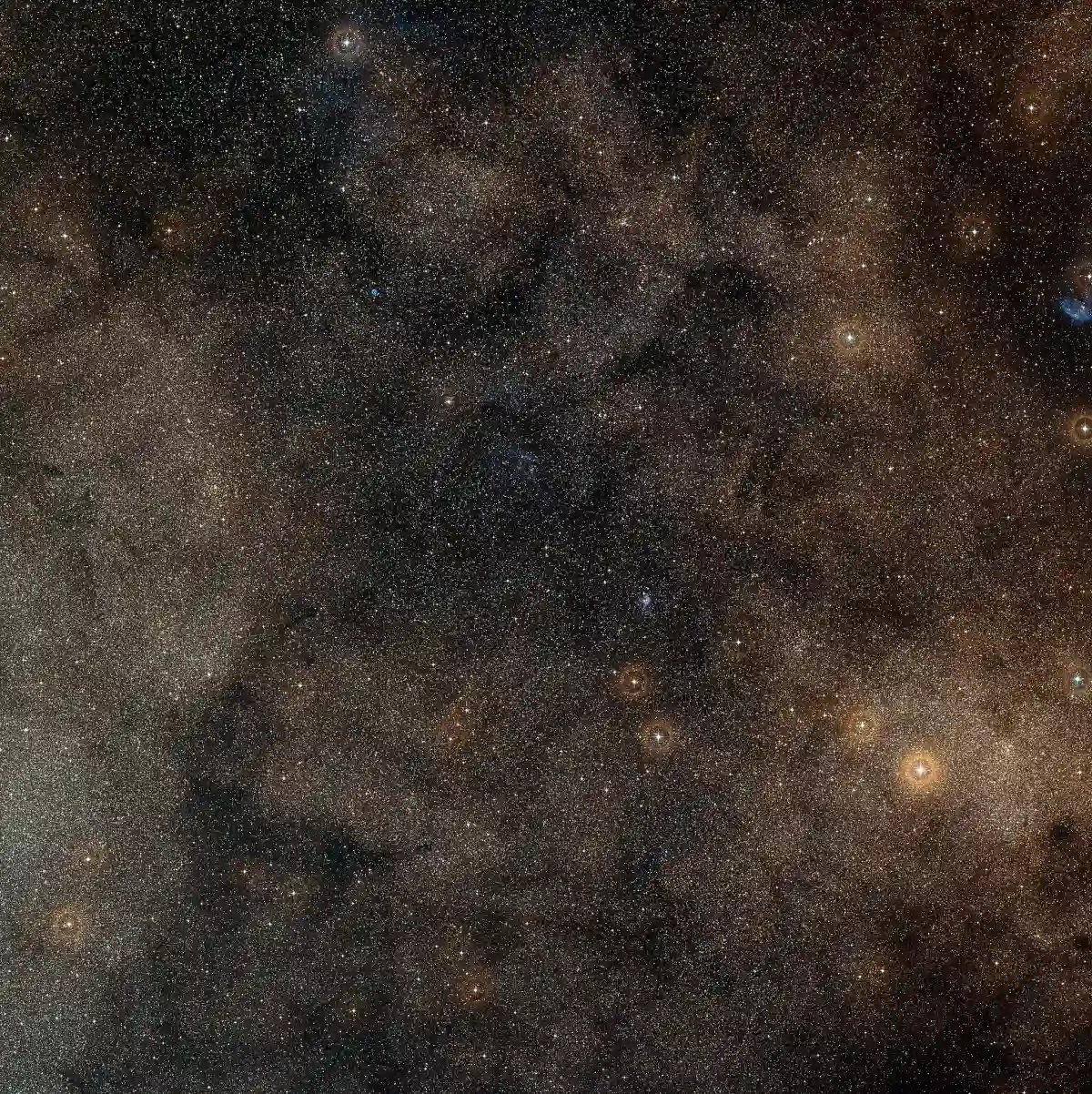
This visible light wide-field image of the region around the yellow hypergiant star IRAS 17163-3907 was created from photographs taken through blue, red and infrared filters and forming part of the Digitized Sky Survey 2. The star appears close to the centre, indistinguishable from thousands of others. This very rich star field in the direction of the centre of the Milky Way also features the blue ring-shaped planetary nebula NGC 6337 to the upper left of centre, as well as several star clusters and some faint clouds of glowing gas. The field of view is approximately 2.9 degrees across. Image credit: ESO and Digitized Sky Survey 2 (CC BY 4.0)
Facts
IRAS 17163-3907 was discovered by the American astronomer Karl G. Henize in 1976. Henize included the object in his catalogue of southern emission-line stars as Henize 3-1379 (Hen 3-1379).
In 1989, Le Bertre et al. classified it as a post-AGB (asymptotic giant branch) star and estimated a distance of 1 kiloparsec.
However, in 2011, a team led by Eric Lagadec of the European Southern Observatory (ESO) determined a lower limit of 3.6 kpc on the distance to the star. The study was based on mid-infrared images taken with the VISIR instrument on the Very Large Telescope (VLT).
The astronomers resolved two concentric dusty shells within 2.5 arcseconds of the central hypergiant star and found a dust mass of 0.04 solar masses and temperature of about 200 K. They determined a total circumstellar mass of over 4 times the mass of the Sun and concluded that IRAS 17163 was a post-red supergiant and possibly a yellow hypergiant.
In 2013, D. Hutsemékers et al. imaged the Fried Egg Nebula with the Herschel Space Observatory. The team estimated a diameter of 1 parsec and a total gas mass of 7 solar masses for the nebula. Since the nebula is not seen in H-alpha, the astronomers concluded that the central star is still in the pre-LBV (luminous blue variable) phase and suggested that it will eventually evolve into a hot luminous blue variable.
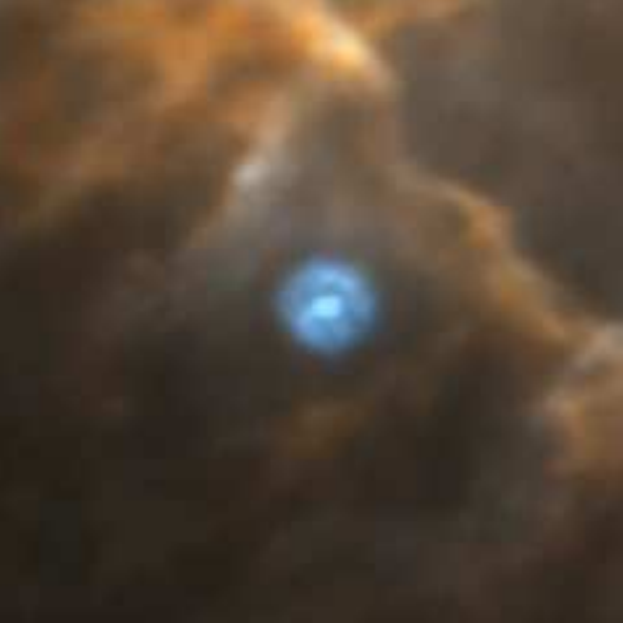
A massive parsec-scale dust ring nebula around the yellow hypergiant Hen 3-1379, image credit: D. Hutsemékers et al. (PD)
The mass of around 22 solar masses was derived in a 2015 study led by Sofia H. J. Wallström, Department of Earth and Space Sciences, Chalmers University of Technology, Onsala Space Observatory, Sweden. The astronomers estimated a radius 370 times that of the Sun and an initial mass of 30 solar masses for the star. The study was published in Astronomy & Astrophysics.
In 2017, Wallström et al. found a large expansion velocity of 100 ± 10 km s-1 for the hypergiant’s stellar wind and a mass-loss rate of 8 ± 1.5 × 10-5 M⊙ yr-1, assuming a constant and isotropic wind. Based on observations with the ALMA Compact Array (ACA), the team discovered a clumpy CO ring that resembles a torus similar to the one around the supernova SN 1987A. Ejection scenarios for the torus indicate that the hypergiant star may have a binary companion.
Location
The Fried Egg Nebula lies in the southern constellation of Scorpius. It appears in the region of the Scorpion’s tail, between Shaula (Lambda Scorpii) at the Scorpion’s stinger and Zeta Scorpii.
IRAS 17163-3907 appears in the same area as planetary nebula NGC 6337 (the Ghostly Cheerio Nebula, mag. 11.90) and the open cluster NGC 6318 (mag. 11.80).
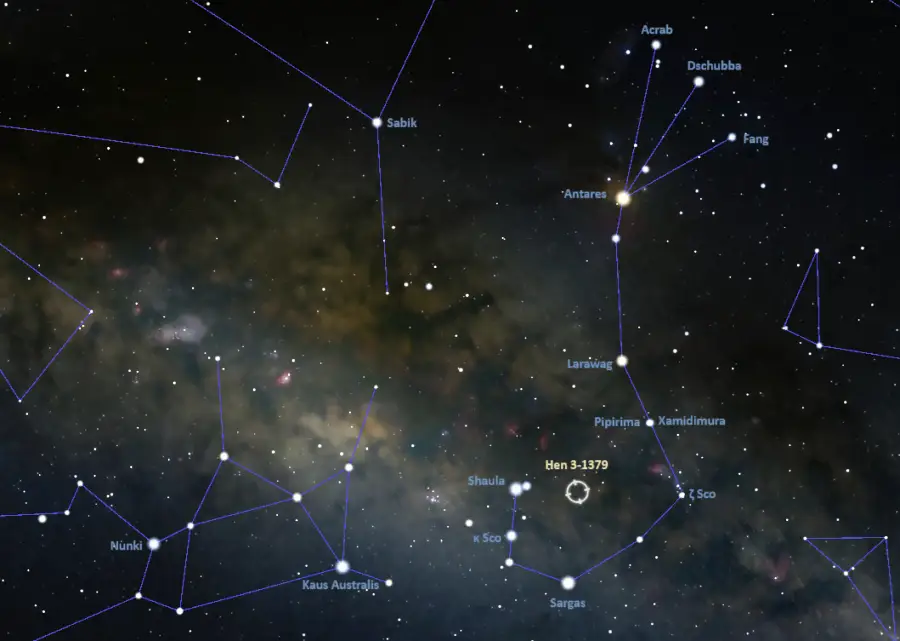
Location of the Fried Egg Nebula (Hen 3-1379), image: Stellarium
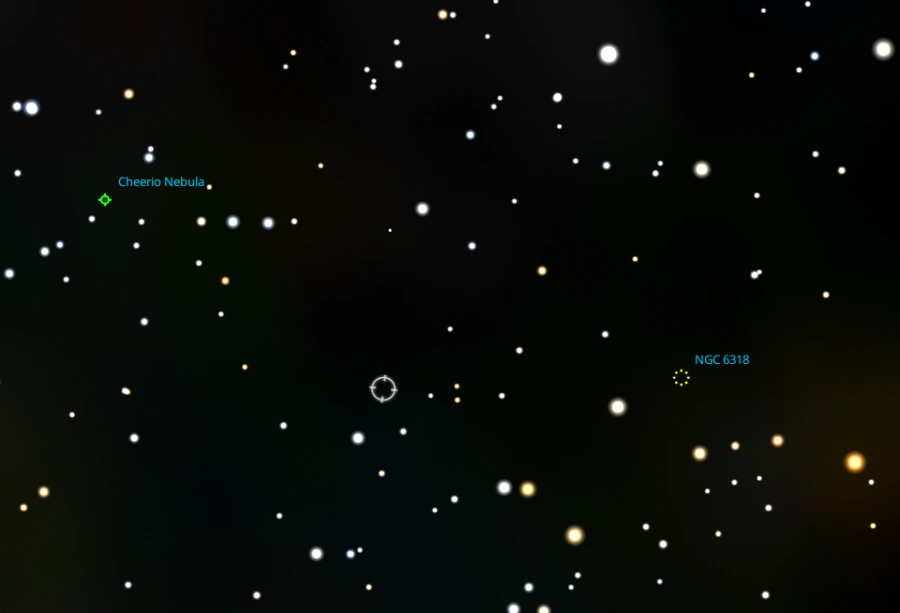
The Fried Egg Nebula, Cheerio Nebula and NGC 6318, image: Stellarium
IRAS 17163-3907
| Constellation | Scorpius |
| Object type | Yellow hypergiant |
| Spectral type | A3-A6Ia |
| J – H colour index | 1.614 |
| J – K colour index | 2.228 |
| Right ascension | 17h 19m 49.3290860880s |
| Declination | −39° 10′ 37.928806356″ |
| Apparent magnitude (V) | 12.45 |
| Apparent magnitude (J) | 4.635 |
| Apparent magnitude (H) | 3.021 |
| Apparent magnitude (K) | 2.407 |
| Absolute magnitude | -10 |
| Distance | 3,913.88 light-years (3,261.56 – 5,218.50 ly); 1,200 parsecs (1,000 – 1,600 pc) |
| Radial velocity | -41.83 ± 2.33 km/s |
| Proper motion | RA: -1.044 ± 0.077 mas/yr |
| Dec.: -2.257 ± 0.053 mas/yr | |
| Parallax | 0.1262 ± 0.0647 mas |
| Mass | ~22 M☉ |
| Radius | 325 R☉ |
| Luminosity | 500,000 L☉ |
| Temperature | 8,300 – 8,500 K |
| Surface gravity | 0.9 cgs |
| Names and designations | Fried Egg Nebula, IRAS 17163−3907, Hen 3-1379, WRAY 15-1676, NSV 21444, GSC2 S2300121509, IRAS 17163-3907, IRSV 1716-3907, 2MASS J17194933−3910374, TIC 193964516, UCAC2 15112979, DENIS J171949.3−391037, GSC 07870−01348, GSC2 S2300121509, MSX6C G348.5107−01.1199, Gaia DR2 5972460442434579968, Gaia DR3 5972460442434579968 |